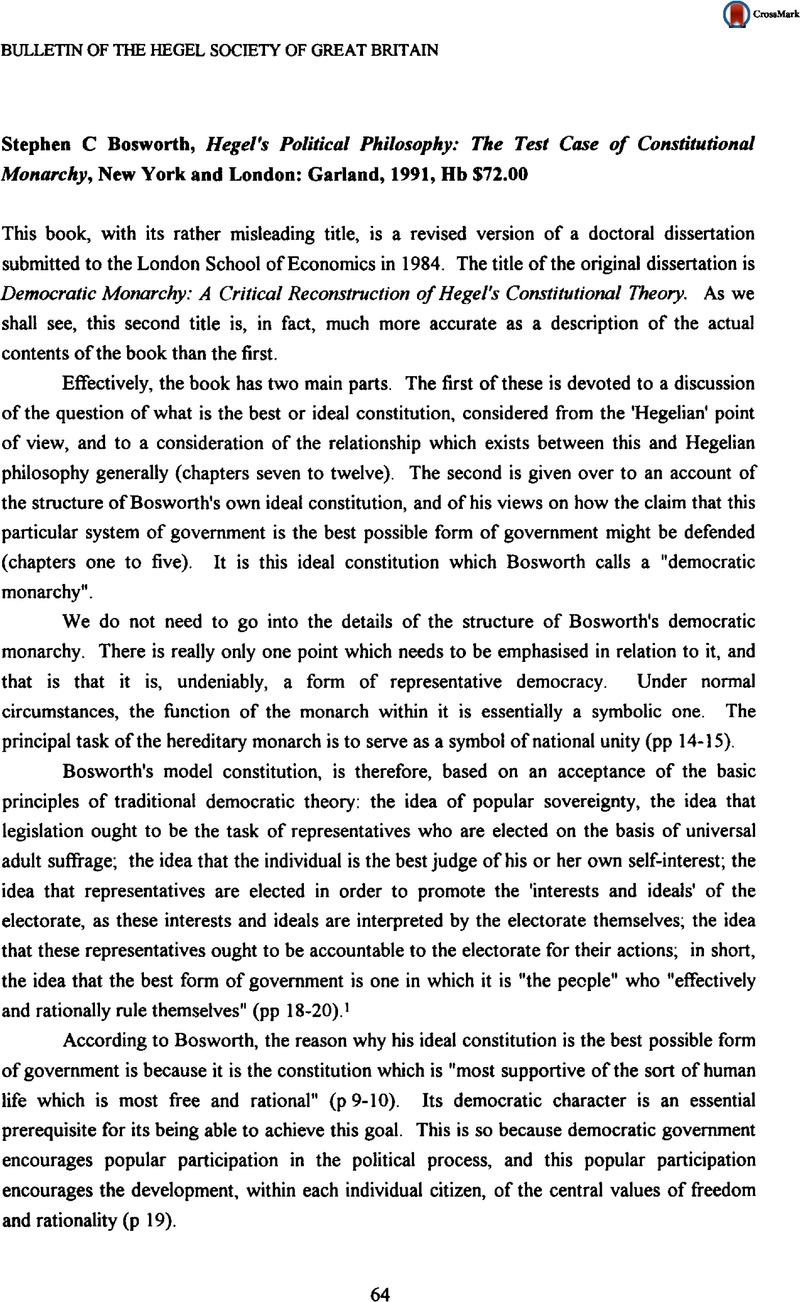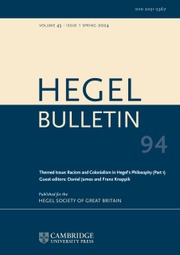No CrossRef data available.
Article contents
Stephen C Bosworth, Hegel's Political Philosophy: The Test Case of Constitutional Monarchy, New York and London: Garland, 1991, Hb $72.00
Review products
Published online by Cambridge University Press: 23 June 2015
Abstract

- Type
- Reviews
- Information
- Bulletin of the Hegel Society of Great Britain , Volume 15 , Issue 2: number 30 , Autumn/Winter 1994 , pp. 64 - 71
- Copyright
- Copyright © The Hegel Society of Great Britain 1993
References
1 For the ideas traditionally associated with democratic theory see inter alia Arblaster, A, Democracy (Open University Press, 1987)Google Scholar; Lively, J Democracy (Blackwell, 1975)Google Scholar; Held, D, Models of Democracy (Polity, 1987)Google Scholar.
2 Cf Brudner, A, “Constitutional Monarchy as the Divine Regime: Hegel's Theory of the Just State”, History of Political Thought, vol 2, no 1 (Spring, 1981), pp 122–125 Google Scholar; Yack, B, “The Rationality of Hegel's Concept of Monarchy”, American Political Science Review, 74 (1980), pp 715–19CrossRefGoogle Scholar.
3 See, for example, Hegel, G W F, Philosophy of Right, ed & trans Knox, T M (Oxford University Press, 1979), para 5, Addition, p 227 Google Scholar; para 29, Remarks, p 33; para 200, Remarks, p 130; para 258, Remarks, pp 156-57; para 272, Remarks, p 175; para 279, Remarks, pp 182-83, para.281, Remarks, p 186; para 301, Remarks, pp 195-96; para 303, Remarks, p.198; para 308, Remarks, p 200; para 309, p 201; para 311, pp 202-03; para 317, pp 204-5; para 318 p 205, and Addition, p 295.
4 The reference is to three traditions of thought. The first is the hermeneutic tradition associated with the H G Gadamer; See Gadamer, H G Truth and Method (New York, 1975)Google Scholar; Gadamer, H G Philosophical Hermeneutics (University of California Press, 1976)Google Scholar; Warnke, G Gadamer: Hermeneutics, Tradition and Reason (Polity Press, 1987)Google Scholar. The second tradition is that associated with the methodological views of Quentin Skinner, especially Skinner's article “Meaning and Understanding in the History of Ideas”, History and Theory vol 8 (1969)Google Scholar. For a discussion of these ideas see Tully, J (ed) Meaning and Context: Quentin Skinner and His Critics (Polity Press, 1988)Google Scholar. The third tradition is that associated with ‘new criticism’ in the field of literary theory. For this see Rylance, R (ed) Debating Texts: a Reader in Twentieth Century Literary Theory and Method (Open University Press, 1987)Google Scholar; Selden, R & Widdowson, P A Readers Guide to Contemporary Literary Theory (Harvester, 1993)Google Scholar; Rice, P & Waugh, P Modern Literary Theory: A Reader, second edition (Edward Arnold, 1993)Google Scholar. Hitherto, these three traditions appear to have had little point of contact with one another.
5 See, especially, Roland Barthes, “The Death of the Author”, in Rice & Waugh. Also, Culler, J, Barthes (Fontana, 1983)Google Scholar; Culler, J, Structuralist Poetics: Structuralism, Linguistics and the Study of Literature (Routledge, 1975)CrossRefGoogle Scholar, and Culler, J Deconstruction: Theory and Criticism After Structuralism (Cornell University Press, 1982)Google Scholar.
6 See, for example, Lerner, L (ed) Reconstructing Literature (Blackwell, 1983)Google Scholar. The title of the book is not without significance.
7 Skinner, Q, “Meaning and Understanding in the History of Ideas”, pp 18-20, 22, 28-29, 48–49 Google Scholar.
8 There is not sufficient space to justify this claim. See Philosophy of Right, Introduction, especially, para 11, p.25; para 15, pp 27-28, and Addition, p 230; para 21, pp 29-30; para 29, p 33. See also, in addition to the references in footnote 3, para 149, p 107, and Addition, pp 259-60; para 150, pp 107-8; and para 153, p 109.




